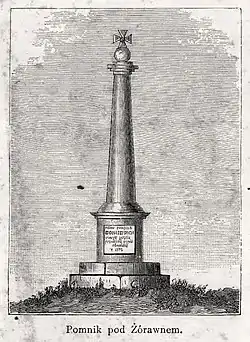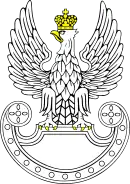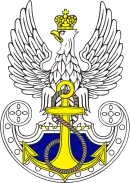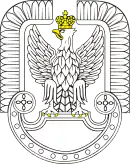Battle of Żurawno
Battle of Żurawno took place between 25 September and 14 October 1676, during the war Polish-Ottoman War (1672–1676). The battle ended in a draw; treaty of Żurawno was signed in its aftermath.
| Battle of Żurawno | |||||||
|---|---|---|---|---|---|---|---|
| Part of Polish-Ottoman War (1672-1676) | |||||||
 Zurawno monument | |||||||
| |||||||
| Belligerents | |||||||
|
|
| ||||||
| Commanders and leaders | |||||||
|
|
| ||||||
| Strength | |||||||
| ca. 20,000 | ca. 40,000 - 50,000 | ||||||
In late August 1676, a large Ottoman-Tatar army of some 50,000 entered the southern Polish province of Pokucie. The invaders were faced by Jan III Sobieski, who had 20,000 soldiers. On 24 September 1676, Polish mounted units clashed with Tatars near Wojnilow and Dolha, and withdrew to the fortified camp in Zurawno.
The Polish camp was protected from two sides by the Dniestr river, while in its front was the Krechowka river. Tatar forces under Selim I Giray concentrated around it by 26 September, while Ottoman units under Ibrahim Seytan arrived there on 28–29 September. The Turks were hoping that King Sobieski would lead his troops out of the camp, to fight a battle in the open field, but the Poles decided to stay in Zurawno. As a result, a prolonged siege began, initiated by a barrage of the Turkish artillery, which continued until 5 October 1676. Since Polish losses were high, Sobieski ordered to abandon the first line of defence, along the old redoubt, and occupy the new line, closer to the center of the camp.
The siege of Zurawno continued until 14 October. Since Turkish losses also were high, and the Poles continued to fight, Ibrahim Seytan decided to initiate negotiations. On 14 October a truce was signed, and three days later the Treaty of Zurawno was signed, ending the second phase of the Polish–Ottoman War (1672–76).
In 1876, on the 200th anniversary of the battle, the Polish population of Zurawno founded a commemorative monument. The monument still exists, but currently is in a very bad condition.


